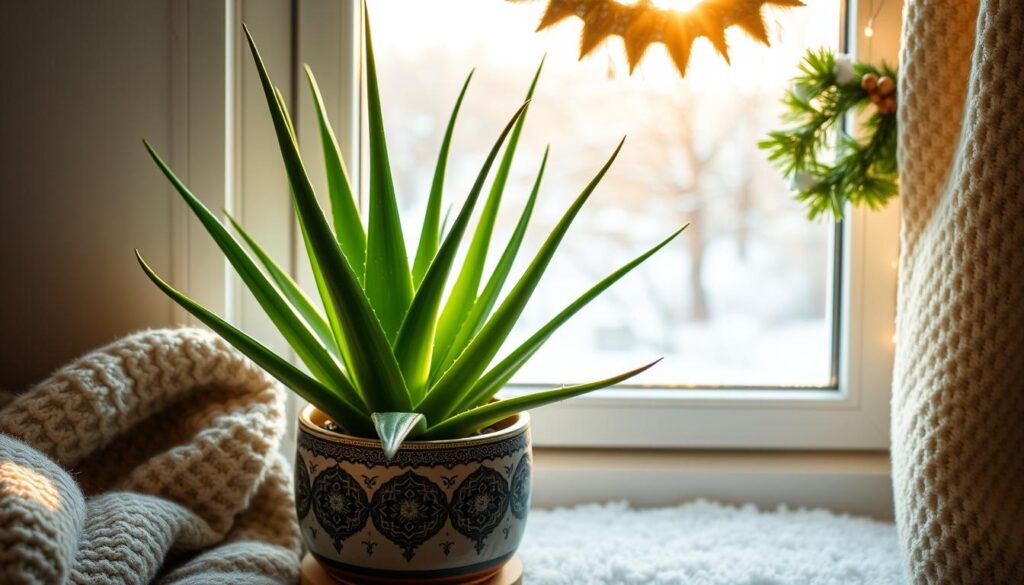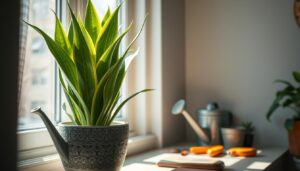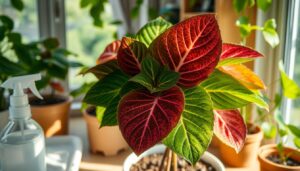As the winter months approach, many of us are looking for ways to keep our homes warm and cozy, while also nurturing our beloved plants. Aloe vera, with its medicinal properties and air-purifying capabilities, is a popular choice for indoor care. But how do we keep this healing succulent thriving in cold homes? Proper Aloe Vera indoor care is essential to maintain its health and benefits.
Medicinal houseplants like aloe vera are not only beautiful additions to our homes, but they also provide numerous health benefits. By learning how to care for our aloe vera plants, we can enjoy their advantages all year round, even in the cold winter months. With the right techniques and tips, you can keep your aloe vera happy and healthy, and reap the rewards of its healing properties.
Introduction to Aloe Vera Care
To get started, it’s essential to understand the basics of aloe vera care. This includes providing the right environment, watering, and fertilizing. By following these guidelines, you can ensure your aloe vera plant remains thriving and continues to provide its medicinal benefits.
Key Takeaways
- Proper Aloe Vera indoor care is crucial for its health and benefits
- Medicinal houseplants like aloe vera provide numerous health benefits
- Aloe vera requires specific care to thrive in cold homes
- Understanding the basics of aloe vera care is essential
- Aloe vera indoor care involves providing the right environment and watering
- With the right techniques, you can keep your aloe vera happy and healthy year-round
Understanding Aloe Vera’s Needs in Winter
Aloe vera is a popular succulent known for its healing properties, but it can be sensitive to cold temperatures. To keep your aloe vera thriving in winter, it’s essential to understand its needs, particularly its Aloe Vera temperature tolerance. Typically, aloe vera can tolerate temperatures above 55°F (13°C), but prolonged exposure to cold can cause stress to the plant.
Recognizing the signs of stress in aloe vera is crucial for providing the right conditions for it to thrive. Some common signs of stress include softening of the leaves or discoloration. By understanding these needs, you can take steps to create an ideal environment for your aloe vera to flourish.
Why Aloe Vera is Sensitive to Cold
Aloe vera is native to warm, dry climates, which makes it sensitive to cold temperatures. When exposed to cold, the plant’s cells can become damaged, leading to stress and potentially even death. To prevent this, it’s essential to keep your aloe vera in a warm, dry place during the winter months.
Recognizing Signs of Stress in Aloe Vera
Some common signs of stress in aloe vera include:
- Softening of the leaves
- Discoloration of the leaves or stems
- Slow growth or no growth at all
By recognizing these signs, you can take action to address the issue and prevent further damage to your plant.
Ideal Indoor Conditions for Aloe Vera
Creating the perfect environment for your aloe vera plant is crucial for its survival and thriving. Aloe vera light needs are quite specific, requiring bright, indirect light to photosynthesize and grow. When it comes to Succulents for low light, aloe vera can tolerate some shade, but it’s essential to provide sufficient light for optimal growth.
Temperature and humidity also play a significant role in aloe vera care. The ideal temperature range is between 65°F to 80°F (18°C to 27°C), while the humidity level should be moderate, around 40-50%. To achieve this, you can use a humidifier or group plants together to create a microclimate.
Temperature and Humidity Preferences
Aloe vera prefers well-ventilated areas with moderate temperatures. Avoid placing your plant near heating or cooling vents, fireplaces, or drafty windows. If you live in an area with low humidity, consider using a humidifier to maintain the ideal humidity level.
Best Placement in Your Home
When deciding where to place your aloe vera, consider the light and temperature conditions. East- or west-facing windows are ideal, as they provide gentle, indirect light. Avoid placing your plant in direct sunlight, which can cause burning. If you don’t have a sunny window, you can use grow lights to supplement the natural light.
Some tips for maintaining the perfect indoor conditions for your aloe vera include:
- Using a thermometer to monitor the temperature
- Placing the plant on a tray with pebbles and water to increase humidity
- Avoiding overwatering, which can lead to root rot
| Factor | Ideal Condition |
|---|---|
| Light | Bright, indirect light |
| Temperature | 65°F to 80°F (18°C to 27°C) |
| Humidity | 40-50% |
Watering Guidelines for Winter Aloe Care
During the winter months, Aloe Vera plants require less water due to their dormant state. Proper Aloe Vera watering tips are essential to prevent root rot and ensure the plant’s survival. It’s crucial to adjust the watering schedule to accommodate the plant’s reduced water needs.
To determine if your Aloe Vera needs water, look for signs such as wrinkled leaves or a soft, mushy texture. If you notice any of these signs, it’s time to water your plant. Here are some tips to keep in mind:
Adjusting Your Watering Schedule
- Water your Aloe Vera plant sparingly, allowing the soil to dry out completely between waterings.
- Reduce the frequency of watering to once a month, or as needed.
- Use room-temperature water to prevent shocking the roots.
Signs That Your Aloe Needs Water
If you’re unsure whether your Aloe Vera needs water, check the soil moisture by sticking your finger into the soil up to the first knuckle. If the soil feels dry, it’s time to water. You can also look for visual signs such as:
- Wrinkled or shriveled leaves
- A soft, mushy texture
- Discoloration or yellowing of the leaves
Soil and Potting Recommendations
When it comes to Growing Aloe indoors, the right soil and potting mix can make all the difference. A well-draining potting mix is essential for aloe vera to prevent waterlogged soil, which can lead to root rot. To ensure your aloe vera thrives, choose a potting mix that is specifically designed for cacti and succulents, as these mixes tend to be more porous and less prone to waterlogging.
Some key characteristics of a good potting mix for Growing Aloe indoors include good drainage, a slightly acidic pH, and a mix of organic and inorganic ingredients. You can also create your own potting mix by combining ingredients such as peat moss, perlite, and vermiculite.
Best Soil for Aloe Vera in Winter
In the winter months, it’s especially important to use a potting mix that will help to prevent waterlogging and root rot. A mix that contains a high percentage of perlite or vermiculite will help to improve drainage and prevent water from accumulating in the soil.
When to Repot Your Aloe Vera
As your aloe vera grows, it will eventually need to be repotted into a larger container. Signs that your aloe vera needs to be repotted include the plant becoming top-heavy, the soil becoming packed and dense, and the plant’s growth slowing down. When repotting, choose a container that is only slightly larger than the previous one, and use a fresh potting mix to give your aloe vera the best chance of thriving.
Fertilizing Aloe Vera: Myths and Truths
Aloe vera is a low-maintenance plant, and its fertilization needs are often misunderstood. During the winter months, aloe vera typically does not require fertilization, as it is in a dormant state. However, this does not mean that fertilization is never necessary. In fact, proper fertilization can support healthy growth and Aloe Vera propagation.
When considering fertilization, it is essential to separate myths from truths. One common myth is that aloe vera needs frequent fertilization to thrive. In reality, over-fertilization can harm the plant, causing more damage than good.
Do Aloe Veras Need Fertilizer in Winter?
The answer is no, aloe veras do not need fertilizer during their dormant winter period. During this time, the plant is not actively growing, and fertilization can do more harm than good.
Best Types of Fertilizer for Succulents
When fertilization is necessary, it is crucial to choose the right type of fertilizer. For succulents like aloe vera, a balanced, water-soluble fertilizer is recommended. Some good options include:
- 20-20-20 fertilizer
- 10-10-10 fertilizer
- Organic fertilizers, such as fish emulsion or compost tea
By understanding the myths and truths surrounding aloe vera fertilization, you can provide your plant with the care it needs to thrive. Remember, Aloe Vera propagation is supported by proper fertilization, but it is essential to fertilize judiciously and only when necessary.
Common Winter Aloe Vera Problems
When it comes to Aloe Vera indoor care, common problems can arise during the winter months. Overwatering and poor indoor conditions can lead to root rot and pest infestations, which can be detrimental to the health and medicinal properties of the plant. As Medicinal houseplants like Aloe Vera require proper care, it’s essential to identify and address these issues promptly.
To prevent root rot, make sure to check the soil moisture regularly and avoid overwatering. Some signs of root rot include soft, mushy stems and leaves. If you notice any of these symptoms, it’s crucial to take action immediately. Here are some steps to treat root rot:
- Remove the plant from the pot and inspect the roots
- Trim any affected roots with sterile scissors
- Repot the plant in well-draining soil

In addition to root rot, pests like mealybugs and spider mites can infest Aloe Vera plants during the winter. To deal with pests, use insecticidal soap or neem oil, and make sure to isolate the plant to prevent the infestation from spreading. By taking proactive measures and providing proper Aloe Vera indoor care, you can keep your Medicinal houseplants healthy and thriving throughout the winter months.
Propagating Aloe Vera in Cold Weather
When it comes to Aloe Vera propagation, many people believe that it can only be done in warm weather. However, with the right techniques, you can successfully propagate Aloe Vera even in cold weather. One of the best methods for Aloe Vera propagation is through leaf cuttings or offsets.
To increase your chances of successful propagation, make sure to choose healthy leaves or offsets from your Aloe Vera plant. You can then plant them in well-draining soil and provide them with the right amount of water and light. Succulents for low light areas can thrive, but Aloe Vera typically requires bright, indirect light to photosynthesize and grow.
Best Methods for Successful Propagation
- Leaf cuttings: Cut off healthy leaves from your Aloe Vera plant, allow them to dry for a few days, and then plant them in well-draining soil.
- Offsets: Remove offsets from your Aloe Vera plant, allow them to dry for a few days, and then plant them in well-draining soil.
Timing Your Aloe Vera Propagation
The best time to propagate Aloe Vera is during the spring or summer months when the plant is actively growing. However, with the right techniques, you can propagate Aloe Vera even in cold weather. Make sure to provide your newly propagated Aloe Vera plants with the right amount of water, light, and nutrients to ensure they thrive.
| Method | Success Rate | Time of Year |
|---|---|---|
| Leaf Cuttings | 80-90% | Spring/Summer |
| Offsets | 90-100% | Spring/Summer |
The Benefits of Aloe Vera in Winter
Aloe vera is a versatile and beneficial plant to have in your home during the winter months. Not only does it thrive in indoor conditions with proper Aloe Vera light needs and Aloe Vera temperature tolerance, but it also provides numerous health benefits. From soothing skin irritations to supporting digestive health, aloe vera is a natural remedy that can be used in various ways.
One of the most significant advantages of having aloe vera in your home is its ability to provide relief from skin irritations and burns. The gel extracted from the plant can be applied topically to calm and soothe the skin, reducing redness and inflammation. Additionally, aloe vera juice can be consumed to support internal health, including digestive issues and immune system function.
- Soothing skin irritations and burns
- Supporting digestive health
- Boosting immune system function
- Providing relief from inflammation and redness
By incorporating aloe vera into your daily routine, you can experience these benefits firsthand and enjoy the advantages of having this versatile plant in your home. With proper care and attention to its Aloe Vera light needs and Aloe Vera temperature tolerance, you can keep your aloe vera thriving and reap its rewards all year round.
Conclusion: Keeping Your Aloe Vera Thriving Year-Round
As you’ve learned throughout this guide, caring for your indoor Aloe Vera during the winter months requires a bit of extra attention. By understanding the plant’s needs, providing the right conditions, and following proper watering, fertilizing, and propagation practices, you can ensure your Aloe Vera remains healthy and vibrant all year long.
Remember to keep a close eye on your Aloe Vera, monitoring for any signs of stress or pests, and adjusting your care routine as needed. With a little bit of consistency and dedication, you can cultivate a thriving Aloe Vera that will not only beautify your indoor space but also provide you with the countless health benefits this remarkable succulent offers.





Pingback: Discover the Best Big Leaf Houseplants for Your Home - Trusted House Plant Guide
Pingback: The Ultimate Guide to Houseplants: 100 Best Indoor Plants for Every Home - Trusted House Plant Guide
Pingback: Succulent Types & Care - Trusted House Plant Guide
Pingback: 10 Best Low-Light Houseplants for a Lush Indoor Oasis - Trusted House Plant Guide
Pingback: 8 Best Pet-Friendly Houseplants for a Happy Home - Trusted House Plant Guide
Pingback: 12 Stunning Indoor Succulents and Cacti for Your Home - Trusted House Plant Guide
Pingback: 8 Stunning Flowering Indoor Plants to Brighten Your Home - Trusted House Plant Guide
Pingback: 10 Gorgeous Houseplants That Thrive in Humidity - Trusted House Plant Guide
Pingback: Ponytail Palm: The Drought-Resistant Houseplant That Handles Cold Like a Pro